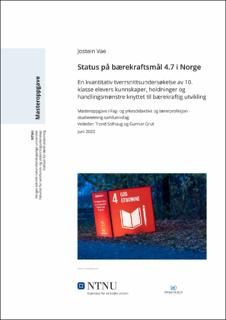| dc.contributor.advisor | Solhaug, Trond | |
| dc.contributor.advisor | Grut, Gunnar | |
| dc.contributor.author | Vae, Jostein | |
| dc.date.accessioned | 2021-09-28T17:47:19Z | |
| dc.date.available | 2021-09-28T17:47:19Z | |
| dc.date.issued | 2020 | |
| dc.identifier | no.ntnu:inspera:55575926:24907215 | |
| dc.identifier.uri | https://hdl.handle.net/11250/2784900 | |
| dc.description.abstract | FN-sambandet har initiert og stipendiert denne masterstuden, hvis formål er en kartlegging i to deler av: 1) elever på tiende trinn i norsk skoles kunnskaper, holdninger og handlingsmønstre knyttet til bærekraftig utvikling (BU), og 2) norske læreplaners tilrettelegging av utdanning for bærekraftig utvikling (UBU) etter kunnskapsløftet ble innført i 2006 (LK06 og R13). En tilsvarende undersøkelse planlegges gjennomført etter læreplanrevisjonen Fagfornyelsen (LK20). Undersøkelsen vil bli gjennomført mot slutten av tiåret. Hensikten er å avdekke læreplaners effekt på elevers læring om BU, og å styrke nasjonal rapportering på FNs bærekraftsmål 4.7
Didaktisk har en målsetting vært å bruke resultatene til å belyse sentrale aspekt ved UBU som kjønnsforskjeller og forskjeller betinget av geografi. Resultatene synliggjør i tillegg hvordan norske skoler underviser i UBU, og hvordan dette feltet kan styrkes didaktisk.
I datainnsamlingen har jeg bygd videre på et måleinstrument tidligere utviklet i kanadisk og svensk skoleforskning. I en nasjonal nettbasert spørreundersøkelse deltok 590 elever på tiende trinn i norske grunnskoler. I tillegg til enkelte bakgrunnsspørsmål inneholder måleinstrumentet 27 indikatorer; ni indikatorer måler kunnskap, ni holdninger, og ni handlingsmønster.
Resultatet fra undersøkelsen viser at elever på tiende trinn i norsk skole har god kunnskap og positive holdninger knyttet til bærekraftrelaterte temaer. Deres handlingsmønster rapporteres imidlertid godt under kunnskap- og holdningsnivået. Det kommer også frem av undersøkelsen at jenter jevnt over har bedre forståelse, mer positive holdninger, og bedre handlingsmønster enn gutter. Mellom elever som bor i by og de som ikke bor i by rapporteres derimot ingen signifikant forskjell.
Undersøkelsen viser videre at positive holdninger til BU er viktigst for å utvikle et adekvat handlingsmønster på feltet. Kunnskapsvariabelen har liten eller ingen forklaringskraft på handlingsmønster, men at like fullt har betydning for hvilke holdninger elevene har til BU.
Utdanning for bærekraftig utvikling i norsk skole har ut fra foreliggende funn størst utfordring knyttet til elevenes handlingsmønstre. Det oppfordres derfor til en mer handlingsrettet undervisning. Fra UBU-litteraturen, samt samfunnsfagdidaktisk teori, må en slik utdanning utøve prinsippet om utdanning i (Koritzinsky) eller utdanning for (Sinnes) bærekraftig utvikling. | |
| dc.description.abstract | UNA Norway has initiated and funded this master thesis, which has a dual purpose: 1) to survey what skills, knowledge and patterns of behaviour Norwegian 10th-grade students possess when it comes to sustainable development (SD), and 2) The facilitation of the teaching of SD (ESD) in Norwegian curricula derived from the principles of “Kunnskapsløftet” (LK06 and R13). A similar survey is planned after the initiation of the curricula revision that is introduced in 2020. That survey is scheduled to be completed by the end of the decade. The overall purpose of the project is to chart how curricula influence students’ knowledge and learning about SD, as well as to strengthen the knowledge about the status of the UN’s sustainable development goal 4.7 in Norway.
The didactic purpose of the project has been to use the results to look at significant aspects of the teaching of SD, such as differences due to gender and geographical location. The results further indicate how Norwegian schools teach sustainable development, and how this field can be strengthened didactically.
In my data collection, I have made use of and expanded a measurement tool previously developed for and used in Swedish and Canadian school research. 590 Norwegian 10th-graders from all over the country participated in the online survey. In addition to some questions about the respondents’ background, the survey contained 27 indicators. Nine measured knowledge, nine measured attitudes, and nine measured patterns of behavior.
The findings of the survey indicate that Norwegian students have good knowledge and positive attitudes regarding topics related to sustainable development. However, the score related to “patterns of behavior” was well below the score in the other two. The survey also shows that girls overall score better than boys related to both skills, knowledge and patterns of behavior. The study found no significant differences between rural and urban students.
The survey further indicates that positive attitudes towards SD is the most important factor in order to develop an adequate pattern of behavior in the field. The knowledge variable has little to no influence on the “pattern of behavior” variable, but still influences their attitudes.
According to this survey, the main challenges in the Norwegian teaching of sustainable development is connected with the students’ patterns of behavior. A more action-oriented teaching method is therefor encouraged. From the ESD-literature, as well as didactics in social science, such an education must practice the principle of education in (Koritzinsky) or education for (Sinnes) sustainable development. | |
| dc.language | | |
| dc.publisher | NTNU | |
| dc.title | Status på bærekraftsmål 4.7 i Norge - En kvantitativ tverrsnittsundersøkelse av 10.klasse elevers kunnskaper, holdninger og handlingsmønstre knyttet til bærekraftig utvikling | |
| dc.type | Master thesis | |
